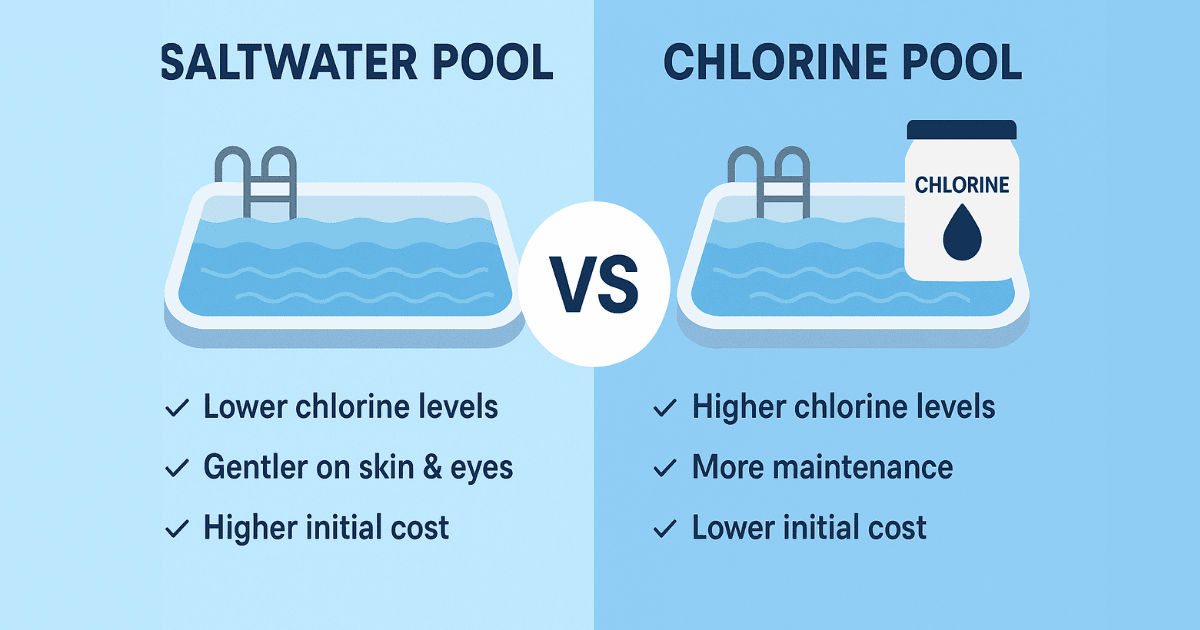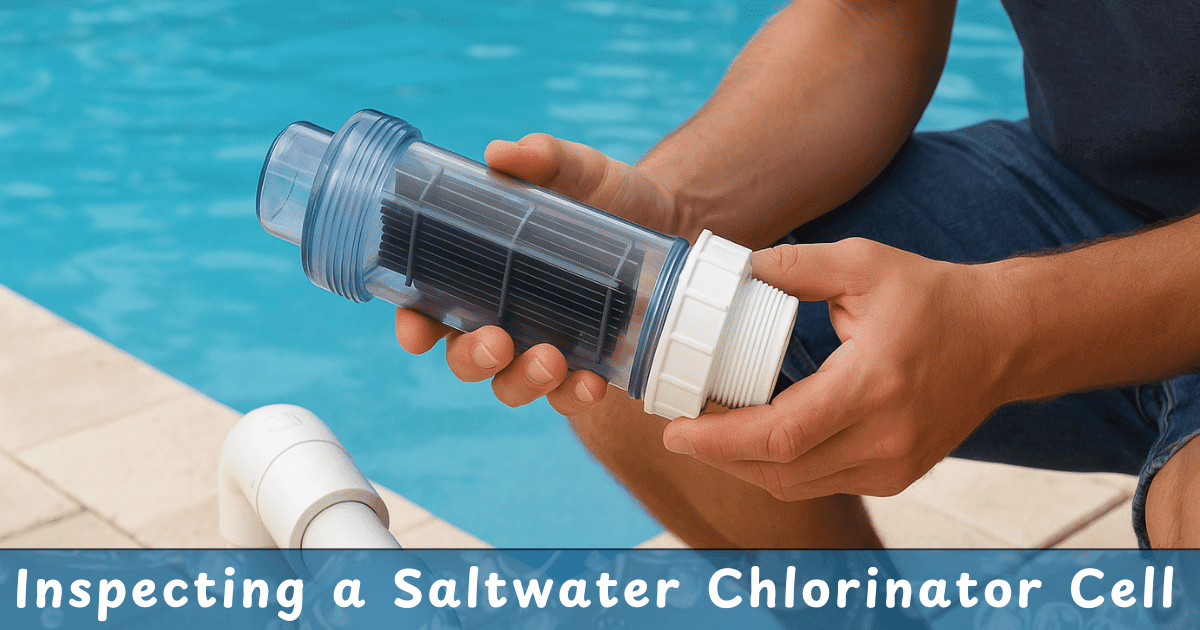Are you tired of constantly manually adding chlorine tablets to your pool? I’ve been there! I’ve never looked back after switching to a saltwater system years ago. Unlike traditional chlorinated pools, saltwater systems continuously generate chlorine through electrolysis as it breaks down salt in the water. This saves you money on purchasing chemicals and offers a great self-maintenance process.
However, one critical aspect of maintaining a saltwater pool that many owners overlook is keeping the salt cell clean. The importance of proper salt cell cleaning compared to other maintenance types can’t be overstated.
In this article, I’ll explain how I clean my salt cell in under 30 minutes, saving hundreds of service calls. I’ll also share my go-to muriatic acid method and a gentler vinegar alternative that works overnight. Let’s start by understanding why this maintenance is so crucial before diving into the step-by-step process.
Salt Pool Maintenance Must-Do
As a salt pool owner myself, I’ve learned that scale buildup is one of the most common challenges we face, often occurring in hard-to-see places within the system. The cell plates inside your electrolytic chlorine generator (or ECG) are particularly vulnerable to this problem. When electricity passes through the dissolved sodium chloride in your water, it creates the sanitizer that keeps your pool clean. But here ‘s the thing, calcium deposits can accumulate silently! These undetected scale formations significantly lower the effectiveness of your salt cell and gradually shorten its lifespan. I once neglected my salt cell for just one season and had to replace it two years early (a $500 mistake) I don’t want you to make!

Regularly inspecting these plates is essential for proper salt cell maintenance and preventing calcium deposits. The difference between a well-maintained salt system and a neglected one isn’t just in water quality; it’s in your wallet, too. I recommend checking your cell inspection viewport monthly during summer and quarterly in winter to catch any scale buildup before it becomes a costly problem.
What causes scale buildup in a salt cell?
Scale buildup in a salt cell doesn’t just happen randomly, it results from a perfect storm inside your system. When your electrolytic chlorine generator (ECG) converts salt into chlorine, it produces NaOH, a by-product that spikes the pH level. If the pH isn’t consistently maintained, especially in warmer water or near pool heaters, it creates a breeding ground for calcium to drop out and mineralize. That’s when calcium forms deposits that develop on the pool surface, inside the equipment, and, most critically, on the salt cell plates. Hotter temperatures and pool chemical solutions only speed this up, causing more scaling over time. If left unchecked, it doesn’t just slow the generator; it can wreck the cell.
How to prevent scale buildup?
Preventing scale buildup in your salt system is easier than dealing with the mess later. The key is keeping the pH balanced and staying ahead of mineral accumulation before it happens. I always recommend using scale control solutions, which you add directly into the circulating water. It’s a simple product you can use monthly as part of your routine. This helps keep your cell clean and protects your equipment from buildup that quietly happens when you least expect it.
How to clean the salt cell and remove scale buildup?
- Turn off the power to the saltwater cell and unplug the power source for safety.
- Disconnect the union connections and carefully remove the salt cell. Loosen the union nuts at the ends and twist free. Make sure the electrical connections are entirely disconnected.
- Prepare a cleaning solution by mixing four parts water and 1 part muriatic acid in a plastic bucket. Always add acid to water to prevent any dangerous chemical reaction.
- Put on rubber gloves and a mask to protect yourself from fumes. Place the salt cell on a salt cell stand so it sits upright. Catch any spills by having the bucket underneath.
- Pour the acid solution over the cell plates. Let the salt cell soak for about 15-20 minutes, during which you’ll see bubbling or fizzing as the solution breaks down the stubborn buildup.
- After soaking, rinse the cell with a garden hose, ensuring all the cleaning solution is washed away. If any mineral deposits or loose debris remain, repeat the soaking process or soak again with a mild acid wash.
- Once the cell is clean, inspect for any remaining scale or stubborn buildup. For a deeper clean, use the cleaning solution and allow the cell plates to soak again until all mineral deposits are removed.
- Rinse thoroughly with fresh water to ensure no residue remains. Carefully safely dispose of the acid mixture according to local guidelines.
- Reinstall the salt cell by connecting the union connections and tightening the union nuts. Double-check that everything is securely in place.
- Finally, turn on the power, check the control panel, and ensure everything runs smoothly without any leaks or issues.
How to Clean Salt Cells with Vinegar

To clean your salt cell with vinegar, ensure the system is turned off by switching off the breakers or placing it in service mode. Disconnect the cell’s wiring and remove the cell. Then, attach a provided cap tightly to the cell, ensuring no vinegar escapes. Pour white vinegar directly into the cell to cover any calcium buildup. Let it soak for up to 24 hours. After soaking, drain the vinegar and use a high-pressure hose to rinse out the loosened deposits, leaving your salt cell clean without harsh chemicals like muriatic acid!
Frequently Asked Questions (FAQ’s)
1. How do I clean my salt cell?
To clean your salt cell, remove it from the plumbing and carefully rinse it with a garden hose. Next, soak the cell in diluted muriatic acid to dissolve stubborn calcium deposits. After 15-20 minutes, rinse it again thoroughly. Once clean, reinstall the cell and reconnect everything.
2. How often does a salt cell need to be cleaned?
Your salt cell should be cleaned regularly, typically every 2-6 months, depending on calcium and mineral deposits. If you have high calcium levels or hard water, cleaning may be needed more frequently to avoid scaling on the plates.
3. What is the ratio of water to acid to clean salt cells?
The ratio of water to acid generally follows a 4:1 mix for cleaning salt cells. Depending on how dirty the salt cell is, you may need to adjust it slightly, but this is a great starting point for most situations.
4. How do you tell if a salt cell needs cleaning?
If your salt cell produces less chlorine or your pool isn’t as clean as it should be, it could be time to clean. Look for signs like calcium deposits or cloudy water. You may also notice restricted water flow or a dirty debris screen. Regular maintenance helps to keep the salt cell in top shape!
5. What happens if you don’t clean a salt cell?
Neglecting salt cell cleaning can reduce chlorine production, making it harder to maintain your saltwater pool. This can cause restricted water flow, affecting the filtration system and the pool pump. Over time, this damage can shorten the longevity of vital components, leading to costly repairs. Regular maintenance is crucial for your pool’s health and smooth operation!





